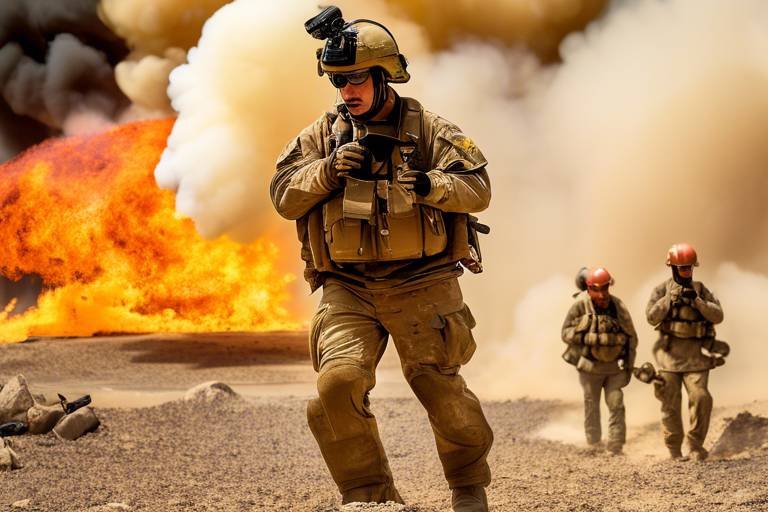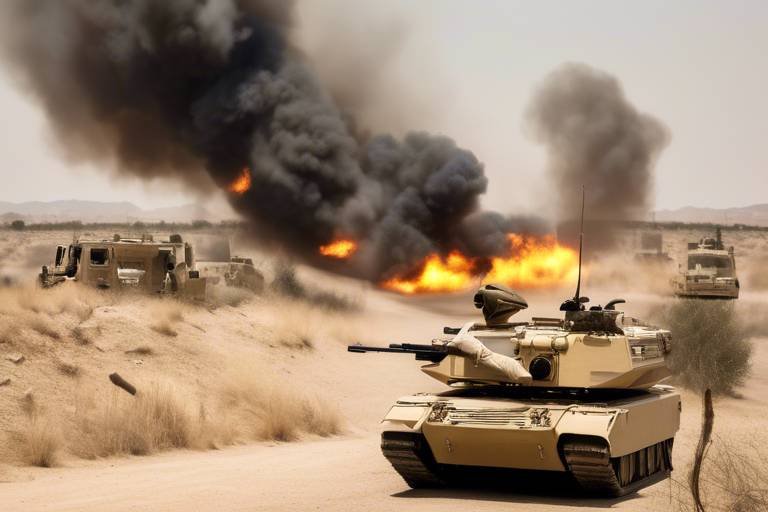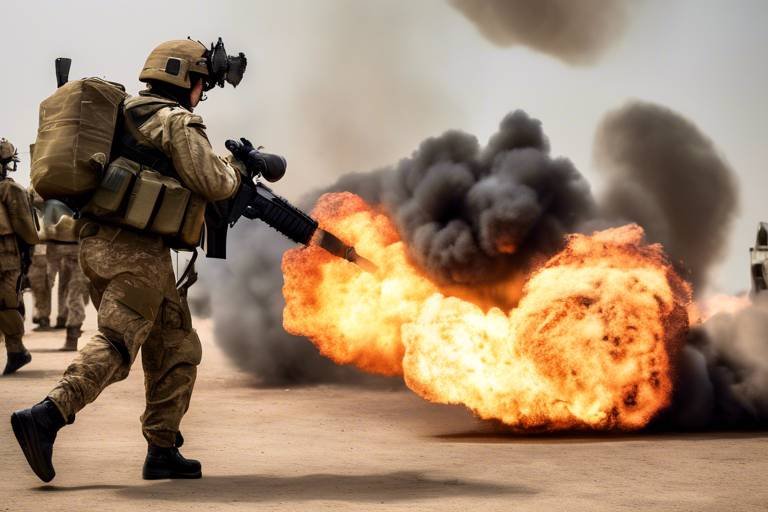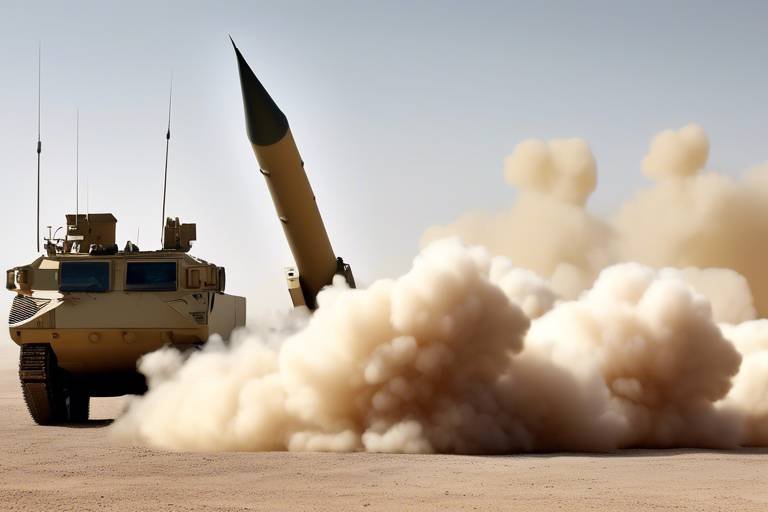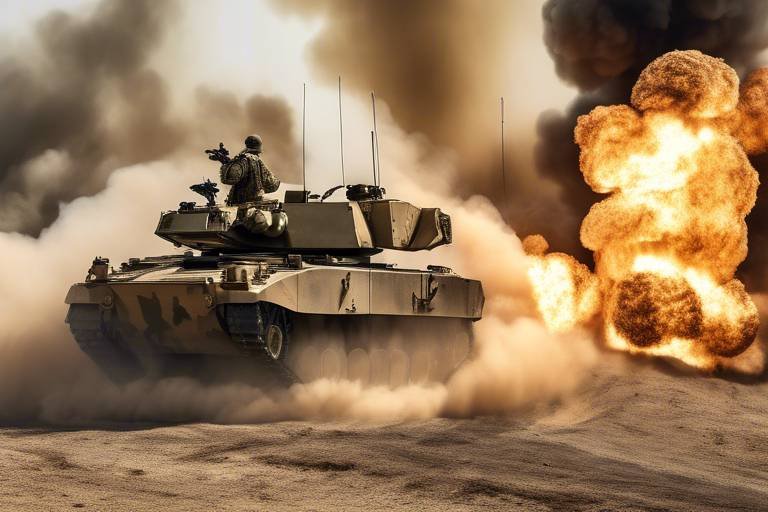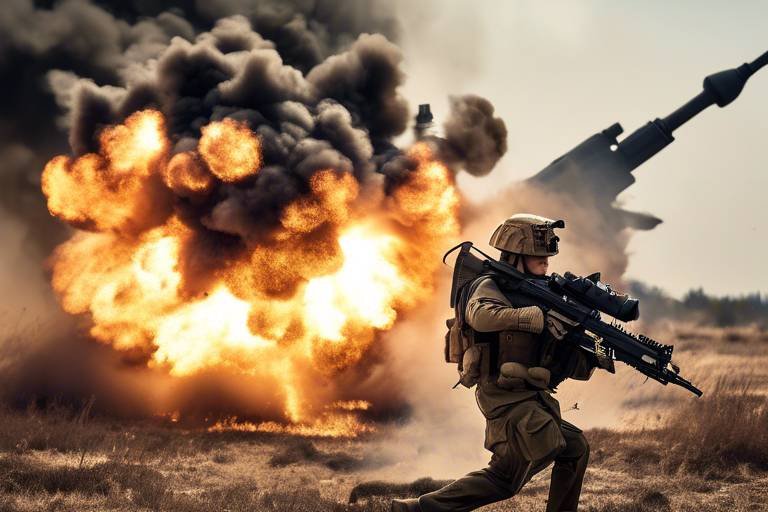The Importance of Fire Support Coordination Centers
In the ever-evolving landscape of modern warfare, the role of Fire Support Coordination Centers (FSCC) has become increasingly critical. These centers act as the nerve center for coordinating various forms of fire support, including artillery, air strikes, and naval gunfire, ensuring that military operations are executed with precision and efficiency. Imagine trying to orchestrate a symphony without a conductor; the FSCC serves that purpose in the chaotic environment of combat, harmonizing the efforts of different units to create a cohesive and effective fighting force.
One of the most striking aspects of FSCC is their ability to integrate diverse fire support capabilities into a unified plan. This integration is not just about firing weapons; it’s about understanding the battlefield, the enemy's movements, and the overall mission objectives. By having a dedicated center focused on fire support coordination, military leaders can make informed decisions that optimize the use of firepower while minimizing the risk of collateral damage. This is crucial, especially in urban warfare scenarios where civilian presence is high, and the stakes are even higher.
Furthermore, the FSCC enhances communication between ground forces and supporting units. Think of it as a high-tech command center where information flows seamlessly, allowing for real-time adjustments to fire support as the situation on the ground changes. This level of coordination is essential for maintaining situational awareness and ensuring that every shot fired counts. Ultimately, the success of any military operation hinges on the ability to adapt and respond to the dynamic challenges of the battlefield, and the FSCC is at the forefront of that effort.
The benefits of integrating FSCC into military operations are manifold. Not only do they improve communication and coordination, but they also enhance the overall effectiveness of fire support. By streamlining the planning and execution of fire missions, the FSCC allows ground troops to focus on their primary objectives, knowing that they have a robust fire support system backing them up. This synergy between units leads to increased mission success rates and a greater likelihood of achieving operational goals.
In conclusion, the importance of Fire Support Coordination Centers in military operations cannot be overstated. They are the backbone of effective fire support, ensuring that every aspect of firepower is utilized to its fullest potential. As military operations continue to grow in complexity, the role of FSCC will only become more vital, solidifying their place as indispensable assets on the modern battlefield.
- What is the primary role of a Fire Support Coordination Center?
The FSCC coordinates artillery and air support, ensuring that firepower is effectively integrated into military operations. - How does technology impact the effectiveness of FSCC?
Modern technology provides real-time data and advanced surveillance capabilities, enhancing target acquisition and decision-making processes. - Why is communication important in military operations?
Effective communication ensures that all units are synchronized, which is crucial for delivering accurate and timely fire support.
Understanding Fire Support Coordination Centers
Fire Support Coordination Centers (FSCC) play a pivotal role in modern military operations, acting as the nerve center for coordinating artillery and air support. Imagine a bustling control room filled with skilled personnel, each contributing to the seamless integration of firepower into combat scenarios. The FSCC ensures that every round fired and every bomb dropped is executed with precision, maximizing effectiveness while minimizing collateral damage. In a world where the fog of war can cloud judgment, the FSCC provides clarity and direction, making it an essential component of operational success.
At its core, the FSCC is designed to facilitate communication and coordination among various military units. This includes ground forces, artillery units, and air support teams, all of whom must work in concert to achieve mission objectives. The FSCC acts as a bridge, linking these disparate elements and ensuring that fire support is not only available but also delivered accurately and timely. Without this coordination, the risk of friendly fire increases, and the potential for mission failure escalates significantly.
The effectiveness of an FSCC is largely dependent on its ability to adapt to rapidly changing environments. In complex combat situations, the dynamics can shift in an instant, requiring quick thinking and decisive action. This is where the FSCC truly shines, utilizing advanced technology and real-time data to make informed decisions. For instance, when enemy positions are identified, the FSCC can quickly assess the best course of action, whether that involves directing artillery fire or calling in air support.
Moreover, the FSCC is not just a reactive entity; it is also proactive in its approach to fire support planning. This systematic method involves analyzing operational needs and allocating resources accordingly. By doing so, the FSCC ensures that all available firepower is utilized efficiently, aligning with the overall strategy of the mission. In essence, the FSCC transforms chaos into order, allowing military units to focus on their primary objectives without being bogged down by the complexities of fire support logistics.
In summary, Fire Support Coordination Centers are indispensable in the realm of military operations. They provide a structured approach to integrating firepower, enhancing communication, and ensuring that each action taken on the battlefield is deliberate and calculated. As we delve deeper into the functions and benefits of FSCC, it becomes increasingly clear that their role is not just beneficial; it is critical for success in modern warfare.
Key Functions of FSCC
The Fire Support Coordination Center (FSCC) plays a pivotal role in military operations, serving as the brain behind the effective integration of fire support. Think of it as the conductor of an orchestra, where each section must harmonize to create a powerful symphony of firepower. The FSCC is responsible for several key functions that are essential for operational success, including target acquisition, fire support planning, and the coordination of joint fires.
First and foremost, target acquisition is a critical function of the FSCC. This process involves identifying and prioritizing targets accurately, ensuring that military units can direct their fire support where it is most needed. Imagine a chess game where every move counts; the FSCC must anticipate the enemy's strategies and respond effectively. The ability to pinpoint high-value targets can mean the difference between mission success and failure.
Effective target acquisition is crucial for the FSCC, as it enables military units to focus their resources on the most pressing threats. Utilizing a combination of intelligence, surveillance, and reconnaissance (ISR) assets, the FSCC gathers real-time data to inform decision-making. This process is not just about finding targets; it’s about making educated choices that can save lives and resources.
Modern technology has revolutionized target acquisition capabilities. With advanced surveillance systems and reconnaissance tools, the FSCC can monitor enemy movements and gather critical information. For instance, unmanned aerial vehicles (UAVs) equipped with high-resolution cameras provide live feeds that are invaluable for identifying enemy positions. This technological edge allows for quicker, more accurate targeting, which is essential in the fast-paced environment of modern warfare.
However, despite these advancements, challenges persist. Enemy countermeasures, such as electronic warfare tactics, can disrupt communication and targeting systems. Additionally, the chaotic nature of combat situations requires rapid decision-making. The FSCC must constantly adapt to these challenges, making it a high-pressure environment where every second counts.
Another crucial function of the FSCC is fire support planning. This systematic approach ensures that all available firepower is allocated effectively. Picture a chef meticulously planning a multi-course meal; each ingredient must be prepared and timed perfectly to create a delightful dining experience. Similarly, fire support planning involves coordinating artillery, air support, and other fire assets to achieve mission objectives seamlessly.
Fire support planning is not just about deploying firepower; it’s about doing so in a way that maximizes effectiveness while minimizing collateral damage. The FSCC assesses the operational environment, considers the capabilities of various units, and devises a comprehensive plan that aligns with the overall mission strategy. This level of coordination is essential in complex combat scenarios, where multiple units may be operating in close proximity.
In summary, the key functions of the FSCC—target acquisition and fire support planning—are vital for the success of military operations. By ensuring that fire support is accurately directed and effectively coordinated, the FSCC enhances the overall operational effectiveness of military forces. The synergy created within the FSCC is what allows ground troops to focus on their primary objectives while relying on a well-orchestrated fire support system.
- What is the main role of the FSCC? The FSCC coordinates artillery and air support, ensuring firepower is effectively integrated into military operations.
- How does technology aid in target acquisition? Modern technology, such as UAVs and advanced surveillance systems, provides real-time data for accurate target identification.
- What are the challenges faced by FSCC? Challenges include enemy countermeasures and the need for rapid decision-making in dynamic combat situations.
- Why is fire support planning important? It ensures that firepower is allocated effectively to achieve mission objectives while minimizing collateral damage.
Target Acquisition
Effective is crucial for Fire Support Coordination Centers (FSCC), as it enables military units to identify and prioritize targets accurately. Imagine trying to hit a moving target in a game of darts while blindfolded; that’s what it can feel like without proper target acquisition in combat. The ability to pinpoint the enemy's location and determine the most critical threats is not just a tactical advantage—it's a matter of life and death. In the chaotic environment of warfare, where every second counts, FSCC plays a pivotal role in ensuring that fire support is directed precisely where it is most needed.
To achieve effective target acquisition, FSCC employs a variety of methods and technologies. This includes the use of advanced surveillance systems and reconnaissance tools that provide real-time data. For instance, drones equipped with high-resolution cameras can scout enemy positions, while ground-based sensors detect movement and relay this information back to the FSCC. This integration of technology allows for a clearer picture of the battlefield, enabling commanders to make informed decisions quickly.
However, it's important to note that despite these advancements, challenges persist in the realm of target acquisition. Enemy countermeasures, such as camouflage and electronic warfare tactics, can obscure visibility and complicate the identification process. Moreover, the need for rapid decision-making in dynamic combat situations can lead to potential errors. In these high-stakes moments, the ability of the FSCC to adapt and respond swiftly can greatly influence the outcome of an operation.
In summary, target acquisition is not merely about spotting the enemy; it involves a complex interplay of technology, strategy, and real-time data analysis. The effectiveness of fire support hinges on the FSCC's ability to acquire and prioritize targets, ensuring that military units can operate with precision and confidence in the field.
Technology in Target Acquisition
This article explores the critical role of Fire Support Coordination Centers (FSCC) in military operations, emphasizing their functions, benefits, and the impact they have on overall mission success.
Fire Support Coordination Centers serve as vital hubs for coordinating artillery and air support, ensuring that firepower is effectively integrated into military operations to maximize effectiveness and minimize collateral damage.
The primary functions of Fire Support Coordination Centers include target acquisition, fire support planning, and coordination of joint fires, which are essential for achieving operational objectives in complex combat environments.
Effective target acquisition is crucial for FSCC, enabling military units to identify and prioritize targets accurately, ensuring that fire support is directed where it is most needed during operations.
In the modern battlefield, technology has revolutionized the way military units conduct target acquisition. Gone are the days of relying solely on visual identification or manual calculations. Today, advanced systems and tools play a pivotal role in ensuring that targets are identified with precision. For instance, satellite imagery and unmanned aerial vehicles (UAVs) provide real-time surveillance, allowing FSCC to gather critical intelligence on enemy positions.
Moreover, technologies such as radar systems and advanced sensors enhance the capabilities of ground forces. These systems can detect movement and changes in the environment, which is essential for identifying potential threats quickly. With the integration of Artificial Intelligence (AI), data analysis is faster, enabling commanders to make informed decisions in the heat of battle. The use of geospatial analysis tools also allows for a more comprehensive understanding of the operational environment, ensuring that every piece of information is utilized effectively.
However, while technology has significantly improved target acquisition, challenges still exist. For example, enemy countermeasures can disrupt communication and data transmission, making it difficult to obtain accurate information. Additionally, the need for rapid decision-making in dynamic combat situations can put pressure on personnel, requiring them to adapt quickly to changing circumstances. Thus, while technology acts as a powerful ally, the human element remains crucial in the effective execution of target acquisition.
Fire support planning is a systematic approach that FSCC employs to allocate resources effectively, ensuring that all available firepower is utilized in a coordinated manner to achieve mission objectives.
The integration of Fire Support Coordination Centers into military operations results in improved communication, enhanced situational awareness, and increased efficiency, ultimately leading to more successful mission outcomes.
FSCC facilitates improved communication between ground forces and supporting units, ensuring that all elements are synchronized and that fire support is delivered accurately and timely.
By streamlining fire support processes, FSCC increases operational efficiency, allowing military units to focus on their primary objectives while relying on coordinated firepower for support.
- What is the primary role of an FSCC? The primary role of an FSCC is to coordinate and integrate fire support from various sources to enhance military operations.
- How does technology aid in target acquisition? Technology aids in target acquisition through advanced surveillance systems, real-time data analysis, and the use of AI, which enhance the accuracy and speed of identifying targets.
- What are some challenges faced in target acquisition? Challenges include enemy countermeasures, rapid decision-making needs, and the potential for misinformation in dynamic combat environments.
Challenges in Target Acquisition
In the fast-paced and chaotic world of military operations, target acquisition presents a myriad of challenges that can significantly impact mission success. Even with the latest technological advancements, the battlefield is unpredictable, and the need for rapid decision-making is paramount. One of the primary challenges is the presence of enemy countermeasures. Adversaries are always looking for ways to disrupt the effectiveness of fire support, employing tactics such as camouflage, deception, and advanced electronic warfare techniques.
Moreover, the dynamic nature of combat means that situations can change in an instant. For instance, a target that was visible moments ago may suddenly vanish behind cover or be moved to a different location, making it crucial for FSCC personnel to adapt quickly. This constant flux can lead to a situation where information is outdated by the time it reaches the decision-makers, resulting in wasted resources and missed opportunities. Additionally, the integration of various intelligence sources—such as satellite imagery, drone reconnaissance, and human intelligence—can sometimes create confusion rather than clarity, as differing reports may lead to conflicting priorities.
Another significant challenge lies in the need for interoperability between various branches of the military and allied forces. Each unit may use different systems, protocols, and terminologies, which can complicate communication and coordination. This lack of uniformity can delay target acquisition and fire support, especially in joint operations where multiple forces are involved. To illustrate this point, consider the following table that highlights some of the common challenges faced in target acquisition:
| Challenge | Description |
|---|---|
| Enemy Countermeasures | Use of tactics to conceal or mislead targeting efforts. |
| Dynamic Battlefield | Rapid changes in target visibility and location. |
| Information Overload | Conflicting reports from multiple intelligence sources. |
| Interoperability Issues | Difficulties in communication between different military branches. |
In summary, while modern technology has vastly improved target acquisition capabilities, the challenges remain significant. The need for swift action, clarity in communication, and adaptability in decision-making is more critical than ever. As military operations evolve, so too must the strategies employed by Fire Support Coordination Centers to overcome these obstacles and ensure that fire support is directed effectively where it is needed most.
- What is the primary role of Fire Support Coordination Centers?
Fire Support Coordination Centers are responsible for coordinating artillery and air support, ensuring effective integration of firepower in military operations. - How does technology impact target acquisition?
Modern technology enhances target acquisition by providing real-time data through advanced surveillance systems and reconnaissance tools. - What are some common challenges in target acquisition?
Challenges include enemy countermeasures, dynamic battlefield conditions, information overload, and interoperability issues among different military branches.
Fire Support Planning
This article explores the critical role of Fire Support Coordination Centers (FSCC) in military operations, emphasizing their functions, benefits, and the impact they have on overall mission success.
Fire Support Coordination Centers serve as vital hubs for coordinating artillery and air support, ensuring that firepower is effectively integrated into military operations to maximize effectiveness and minimize collateral damage.
The primary functions of Fire Support Coordination Centers include target acquisition, fire support planning, and coordination of joint fires, which are essential for achieving operational objectives in complex combat environments.
Effective target acquisition is crucial for FSCC, enabling military units to identify and prioritize targets accurately, ensuring that fire support is directed where it is most needed during operations.
Modern technology enhances target acquisition capabilities, utilizing advanced surveillance systems and reconnaissance tools to provide real-time data for informed decision-making in fire support operations.
Despite technological advancements, challenges remain in target acquisition, including enemy countermeasures and the need for rapid decision-making in dynamic combat situations.
Fire support planning is a systematic approach that FSCC employs to allocate resources effectively, ensuring that all available firepower is utilized in a coordinated manner to achieve mission objectives. Think of it like orchestrating a symphony where every instrument must play its part in harmony to create a powerful performance. In this context, fire support planning involves several critical elements:
- Assessment of Operational Needs: Before any fire support can be planned, it’s essential to assess the operational landscape. This includes understanding the enemy's capabilities and the terrain.
- Resource Allocation: FSCC must determine how to allocate artillery and air support resources effectively. This involves balancing the need for immediate firepower with the availability of those resources.
- Coordination with Other Units: Fire support planning requires close coordination with infantry, armor, and aviation units to ensure that everyone is on the same page. This synchronization is vital to avoid friendly fire incidents and ensure maximum effectiveness.
Moreover, fire support planning is not a one-time event but rather an ongoing process. As the battlefield evolves, so too must the plans. This adaptability allows FSCC to respond to changes in enemy tactics or unexpected developments on the ground. The ability to pivot quickly can mean the difference between mission success and failure.
In addition, FSCC utilizes advanced software tools that facilitate the planning process. These tools allow for rapid simulations of different scenarios, helping commanders visualize the potential outcomes of various fire support strategies. By employing such technology, military planners can make more informed decisions, ultimately leading to better mission outcomes.
The integration of Fire Support Coordination Centers into military operations results in improved communication, enhanced situational awareness, and increased efficiency, ultimately leading to more successful mission outcomes.
FSCC facilitates improved communication between ground forces and supporting units, ensuring that all elements are synchronized and that fire support is delivered accurately and timely.
By streamlining fire support processes, FSCC increases operational efficiency, allowing military units to focus on their primary objectives while relying on coordinated firepower for support.
- What is the primary role of a Fire Support Coordination Center?
The primary role of an FSCC is to coordinate artillery and air support to ensure effective firepower integration in military operations. - How does technology impact fire support planning?
Technology enhances fire support planning by providing real-time data and simulations, allowing commanders to make informed decisions quickly. - What are some challenges faced by FSCC?
Challenges include enemy countermeasures, the need for rapid decision-making, and maintaining communication across various units.
Benefits of FSCC in Operations
The integration of Fire Support Coordination Centers (FSCC) into military operations is like the backbone of a well-structured army; it supports and enhances every move made by ground forces. One of the most significant benefits of FSCC is the improved communication between various military units. Imagine trying to play a game of chess without knowing what your opponent is doing; that’s how chaotic operations would be without FSCC. By facilitating clear and concise communication channels, FSCC ensures that ground forces and supporting units are synchronized, allowing for timely and accurate delivery of fire support when it matters most.
Moreover, FSCC enhances situational awareness. In the fog of war, information is power. With FSCC, commanders have access to real-time data and intelligence, which helps them make informed decisions quickly. This level of awareness is crucial in dynamic combat situations where the landscape can change in an instant. For example, if enemy forces reposition, FSCC can quickly adapt fire support plans, ensuring that firepower is directed to the most critical areas. This adaptability not only saves lives but also increases the likelihood of mission success.
Another noteworthy benefit is the increased efficiency in operations. By streamlining fire support processes, FSCC allows military units to concentrate on their primary objectives without getting bogged down by the complexities of coordinating firepower. Think of it this way: it’s like having a skilled conductor leading an orchestra; each musician knows their part and comes together to create a harmonious performance. In the same vein, FSCC ensures that all elements of fire support work in unison, maximizing the effectiveness of available resources.
Additionally, the use of FSCC can lead to a decrease in collateral damage. With precise target acquisition and coordinated fire support, the chances of unintended consequences are significantly reduced. This is particularly important in modern warfare, where civilian lives and infrastructure must be safeguarded. The FSCC’s ability to integrate various forms of firepower—be it artillery, air support, or naval gunfire—means that military operations can be executed with a level of precision that was previously unattainable.
In summary, the benefits of Fire Support Coordination Centers in military operations are profound and far-reaching. They not only enhance communication and situational awareness but also increase efficiency and reduce collateral damage. As military operations continue to evolve, the role of FSCC will undoubtedly become even more crucial in ensuring mission success.
- What is the primary role of an FSCC?
The primary role of an FSCC is to coordinate fire support from various units to ensure effective and efficient use of firepower during military operations. - How does FSCC improve communication?
FSCC improves communication by establishing clear channels between ground forces and supporting units, enabling timely and accurate delivery of fire support. - What technologies are used in FSCC?
Modern FSCC utilize advanced surveillance systems, reconnaissance tools, and real-time data analytics to enhance target acquisition and fire support planning. - Why is situational awareness important in military operations?
Situational awareness is crucial because it allows commanders to make informed decisions quickly, adapting to changes in the battlefield environment effectively.
Enhanced Communication
In the fast-paced world of military operations, communication is not just important; it is absolutely essential. Fire Support Coordination Centers (FSCC) act as the nerve center for communication between ground forces and their supporting units. Imagine trying to conduct a symphony without a conductor; that’s what military operations would be like without effective communication facilitated by FSCC. They ensure that every element of the operation is synchronized and that fire support is delivered with pinpoint accuracy and timing.
The FSCC employs various communication technologies and protocols to maintain a seamless flow of information. This includes radio communications, data links, and satellite communications, which are vital for relaying real-time information about troop movements, enemy positions, and the status of fire support missions. The integration of these systems allows for a level of situational awareness that is crucial for making informed decisions on the battlefield.
However, it’s not just about having the right tools; it’s also about the people who use them. The personnel within an FSCC are trained to communicate effectively under pressure, ensuring that critical messages are conveyed quickly and clearly. They must be adept at interpreting complex situations and translating them into actionable intelligence. This level of expertise allows for rapid adjustments to fire support plans, which can be the difference between success and failure in a mission.
Furthermore, enhanced communication through FSCC leads to a more cohesive operational strategy. When ground troops can communicate their needs and receive immediate feedback, it fosters a sense of trust and collaboration among units. This synergy is vital for executing complex maneuvers where timing and coordination are everything. In essence, the FSCC transforms the battlefield into a more organized and efficient environment, where every soldier knows their role and how to coordinate their efforts with others.
To illustrate the impact of enhanced communication, consider the following table that outlines the key components of communication facilitated by FSCC:
| Component | Description | Impact on Operations |
|---|---|---|
| Radio Communications | Real-time voice communication between units | Immediate feedback and coordination |
| Data Links | Transfer of tactical data and situational reports | Enhanced situational awareness and planning |
| Satellite Communications | Global communication capabilities | Connects units across vast distances |
In conclusion, the role of FSCC in enhancing communication cannot be overstated. By ensuring that all units are on the same page, FSCC not only improves the effectiveness of fire support but also contributes to the overall success of military operations. In an environment where every second counts, the ability to communicate effectively can be the key to victory.
- What is the primary role of an FSCC? The primary role of an FSCC is to coordinate artillery and air support for military operations, ensuring effective integration of firepower.
- How does technology enhance communication in FSCC? Technology enhances communication through advanced systems like radio, data links, and satellite communications, allowing for real-time information sharing.
- Why is target acquisition important for FSCC? Effective target acquisition allows for accurate identification and prioritization of targets, ensuring that fire support is directed where it is most needed.
Increased Efficiency
When it comes to military operations, efficiency is not just a buzzword; it's a necessity. Fire Support Coordination Centers (FSCC) play a pivotal role in enhancing operational efficiency by streamlining the processes related to fire support. Imagine a well-oiled machine where every cog works in harmony to achieve a common goal—this is the essence of FSCC in action. By providing a centralized hub for coordination, FSCC ensures that all units involved in an operation can focus on their primary objectives without getting bogged down by the complexities of fire support logistics.
One of the key ways FSCC boosts efficiency is through the elimination of redundancy. In chaotic combat environments, miscommunication can lead to duplicated efforts or, worse, friendly fire incidents. FSCC mitigates these risks by ensuring that all fire support requests are channeled through a single point of command. This centralized command structure allows for real-time updates and adjustments, ensuring that resources are allocated effectively and that every unit is on the same page.
Moreover, FSCC enhances efficiency by utilizing advanced technology and data analytics. By employing sophisticated systems for tracking and managing fire support assets, they can quickly assess the battlefield situation and make informed decisions. For instance, when a ground unit identifies a target, the FSCC can rapidly evaluate the best available fire support options—be it artillery, airstrikes, or naval gunfire—and deploy the most effective solution in a timely manner. This kind of rapid response is crucial in dynamic combat situations where every second counts.
To illustrate the impact of FSCC on operational efficiency, consider the following table that compares traditional fire support methods with FSCC-integrated approaches:
| Aspect | Traditional Method | FSCC-Integrated Method |
|---|---|---|
| Communication | Fragmented, often leading to delays | Centralized, allowing for real-time updates |
| Resource Allocation | Reactive, often inefficient | Proactive, maximizing firepower usage |
| Decision-Making Speed | Slower due to multiple points of contact | Faster with streamlined processes |
| Mission Success Rate | Variable, dependent on coordination | Higher, due to enhanced synchronization |
In summary, the increased efficiency brought about by Fire Support Coordination Centers is a game-changer in military operations. By centralizing command, utilizing technology, and fostering clear communication, FSCC not only enhances the effectiveness of fire support but also allows ground forces to concentrate on their core missions. In the high-stakes environment of combat, where every decision can have life-or-death consequences, the efficiency gained through FSCC could very well be the difference between success and failure.
- What is the primary role of an FSCC? The primary role of an FSCC is to coordinate and manage fire support from various units, ensuring that artillery and air support are effectively integrated into military operations.
- How does technology improve the efficiency of FSCC? Technology enhances FSCC efficiency by providing real-time data for decision-making, enabling rapid response to changing battlefield conditions.
- What challenges do FSCC face in operations? FSCC face challenges such as enemy countermeasures, the need for rapid decision-making, and the complexities of coordinating multiple units.
- Why is communication important for FSCC? Effective communication is crucial for FSCC to ensure that all units are synchronized and that fire support is delivered accurately and in a timely manner.
Frequently Asked Questions
- What is the primary role of a Fire Support Coordination Center (FSCC)?
The primary role of an FSCC is to serve as a central hub for coordinating artillery and air support during military operations. It ensures that firepower is effectively integrated into operations, maximizing effectiveness while minimizing collateral damage.
- How does FSCC enhance target acquisition?
FSCC enhances target acquisition by utilizing advanced surveillance systems and reconnaissance tools. These technologies provide real-time data, allowing military units to accurately identify and prioritize targets, ensuring that fire support is directed where it is most needed.
- What are the challenges faced by FSCC in target acquisition?
Despite technological advancements, FSCC faces challenges such as enemy countermeasures and the necessity for rapid decision-making in dynamic combat situations. These factors can complicate the process of accurately identifying and engaging targets.
- How does fire support planning work within FSCC?
Fire support planning is a systematic approach that FSCC employs to allocate resources effectively. It ensures that all available firepower is utilized in a coordinated manner, aligning with mission objectives to enhance operational success.
- What benefits does FSCC provide in military operations?
FSCC provides numerous benefits, including improved communication between ground forces and supporting units, enhanced situational awareness, and increased efficiency. These elements work together to lead to more successful mission outcomes.
- How does FSCC improve communication during operations?
FSCC enhances communication by facilitating synchronization between ground forces and supporting units. This ensures that fire support is delivered accurately and in a timely manner, which is crucial for mission success.
- In what ways does FSCC increase operational efficiency?
By streamlining fire support processes, FSCC increases operational efficiency. This allows military units to concentrate on their primary objectives while relying on the coordinated firepower provided by the FSCC for support.

